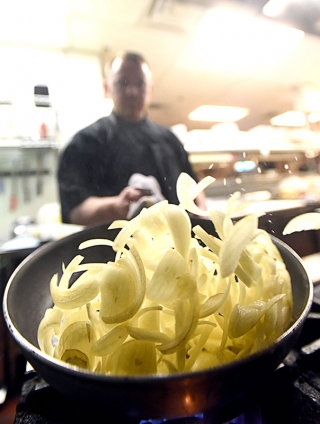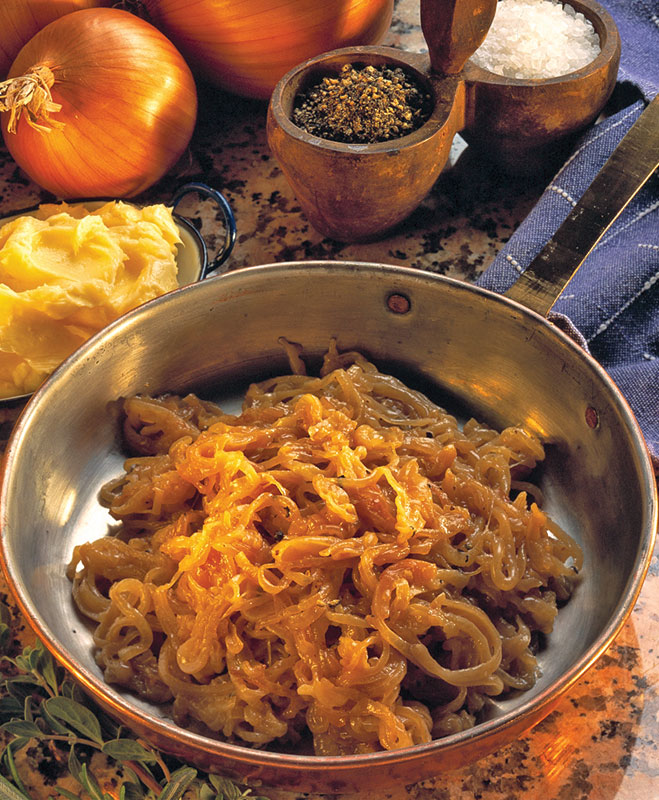
Don’t Skimp on Caramelizing Onions
27 March 2020Tricks to speed up caramelizing onion time fall short on taste and texture.
By René Hardwick, National Onion Association
 Nothing beats the sweet, decadent flavor of caramelized onions. But, if ever there was a vegetable that needed some patience and time, this is it.
Nothing beats the sweet, decadent flavor of caramelized onions. But, if ever there was a vegetable that needed some patience and time, this is it.
Caramelizing onions is a long process and you just have to get used to it, says Chef Justin Brown, owner of Gourmet Grub Scratch Kitchen in Greeley, Colo. “I can assure you, there’s no beating the right way,” Brown said. “The right way is just the right way.”
When onions caramelize, you are using heat to slowly break them down to release their natural sugars and that just takes a long time. A good French Onion Soup, as an example, will have you caramelizing onions for an hour, Brown said. They are worth the wait, he and other chefs say. Artificially speeding up the process may offer a quicker cooking time, but it also cheats the texture and flavor.
“Take the time to do things right and the results will pay off,” said Chef Aran Essig, CEC, CCA, Food Fanatic Chef, US Foods.
The whole process is similar to a diamond’s journey. There is a reason they take a good billion years to properly form, and only when they are ready will the volcanic eruptions push them to the surface.
The cheats
As with any long process these days, finding ways to make something quicker or less cumbersome is just the natural course of action. That’s why microwave ovens, slow cookers, pressure cookers, or cubic zirconia gemstones were invented.
In the last year, a popular “cheat” has surfaced on the internet to move caramelization along quicker, but it’s receiving mixed reviews.
That cheat is adding baking soda. Food blogger Lori Rice tested out this method in 2019 for the National Onion Association, coming to the conclusion that adding 1/8 teaspoon of baking soda per pound of onions will not mess with the flavor while cutting down caramelization time to about 13 minutes.
Baking soda increases the Ph level, thus making the onions brown and soften quicker. Adding baking soda, salt or even sugar will speed up the process because it helps extract the moisture from the onion, albeit not as naturally as the traditional method. Rice noted that it’s important not to add too much baking soda, as it will create a chemical-like taste to your onions.
Still, artificially speeding up the process does have some drawbacks. She noted that the onions “dissolved a bit more and became creamy, almost like an onion jam.”
Would she use this method again? Yes, she said. “For blending the onions into dips or spreading onto a sandwich, caramelizing with baking soda provides the perfect end result,” Rice said. “The soft texture allows them to blend right in with other ingredients and they are nearly spreadable.”
She also recommended using a nonstick pan as the onions made a much bigger mess.
However, not all chefs want to stray from their original caramelization playbook. Chef Essig said baking soda is a cheat that makes you give up a lot. He used green beans as an example. Adding baking soda to blanching water makes the green color vibrant, but you give up the nutrients and the beans will take on a mushy texture. “There is an alkaline taste, but you can compensate by adding acids like wine, vinegar or tomato. With onions, much of the same is true,” Essig said. “The caramelized onions will be mushy, slightly off in flavor and will be devoid of most nutrient value. It does cause them to caramelize faster, but my personal opinion is that you are sacrificing too much.”
Chef KateLynn Dunning, former culinary instructor and assistant catering manager with Cox Business Convention Center and the BOK Arena Center of Tulsa, Okla., said she prefers the “low and slow” method rather than baking soda.
“When caramelizing onions, you are literally converting the carbohydrates locked in the onion into sugars and then transforming those sugars into delicious caramel,” Dunning said. “You want the sweetness from the caramel.”
Let nature take its course
There’s not a lot you can do to speed up or change the caramelization process without losing something. Just accept this is one process worth the wait and doing it right will add the flavor and texture in which onions are known.
Start with evenly sliced onions and a shallow pan covered with butter or oil on low heat. Sweat the onions by covering them with a lid to keep them moist. Then, increase the heat to medium. When the edges of the onions turn brown, turn the heat down to a simmer to continue the process for full browning. That could take another 20 to 30 minutes.
“You really want the process to go through its natural state,” Chef Brown says. “It’s important because you’re really extracting or reducing the actual flavor from the vegetable itself. The more you speed up that process, that sugar and flavor won’t be there.”
Chef Dunning said millennials worry more about knowing where their food comes from than knowing the spoils of their handiwork in the kitchen. The Chef also said she is a millennial herself. Perfecting caramelized onions is worthy of the time it takes if anything for bragging rights of a well-made dish.
Just like a fine diamond, there is no substitute for the original. Here are some tips to turning out the best caramelized onions:
- Cut onion slices evenly, said Chef Brown. If they are not cut evenly, they will not cook evenly. “It makes them not cook at the same time, so you’re sitting there waiting for the rest to caramelize when the ones that are thin enough already have (cooked).”
- If onions start to look dry or stick to the pan, add small amounts of water to moisten and dissolve the burning sugars.
- You can add your own touch to caramelization to enhance the flavor. Chef Brown uses bourbon and brown sugar to create his signature Bourbon Onions. He also suggests any herbs and spices, or other liquor combinations you want to try. You can also experiment with different types of onions to see which onions suit your recipes best.
- For a less hands-on approach, you can caramelize your onions in the oven, according to “The Onion Cookbook,” by Brian Glover. In the oven, he writes, they do not need to be stirred as often. Place thickly sliced onions in a roasting pan or on a baking tray, season with salt and pepper to taste, add herbs if you prefer, and sprinkle with a little olive oil. Cover with aluminum foil and cook at 375 degrees for 30 minutes. Uncover, stir in 1 teaspoon of sugar and sprinkle a little wine or balsamic on the onions. Return to the oven uncovered, and cook for another 25 to 35 minutes, stirring once or twice.
Click here for step-by-step instructions on how to caramelize onions.
Fun foodie take on toffee and caramelized onions
For a fun “foodie” take on caramelized onions, try this recipe from Chef Dunning. She takes a traditional honeycomb toffee treat and adds caramelized onions to create a crunchy, sweet garnish for meats.
She says, “A delicious toffee treat called Honeycomb Toffee is made with brown sugar and baking soda (sometimes with a splash of vinegar if an acidic bump in needed). It is essentially made by traditionally caramelizing the brown sugar and then adding the baking soda and vinegar at the desired level of caramelization to create a super science-fair-winning reaction that bubbles and foams and then ‘dries’ to resemble the bee familiar ‘honeycomb’ shape.
“If you are a super foodie and want to try something crazy, caramelize your onions (the low and slow way) and add a 1/4 cup of brown sugar. Slowly caramelize the brown sugar — with your onions in the caramel — and then throw in your baking soda. Viola: Caramelized Onion Honeycomb Toffee! Try that crumbled on top of Rotisserie Chicken or on a butter-basted Rib Eye Steak.”
Click here for the Caramelized Onions Honeycomb Toffee recipe.
